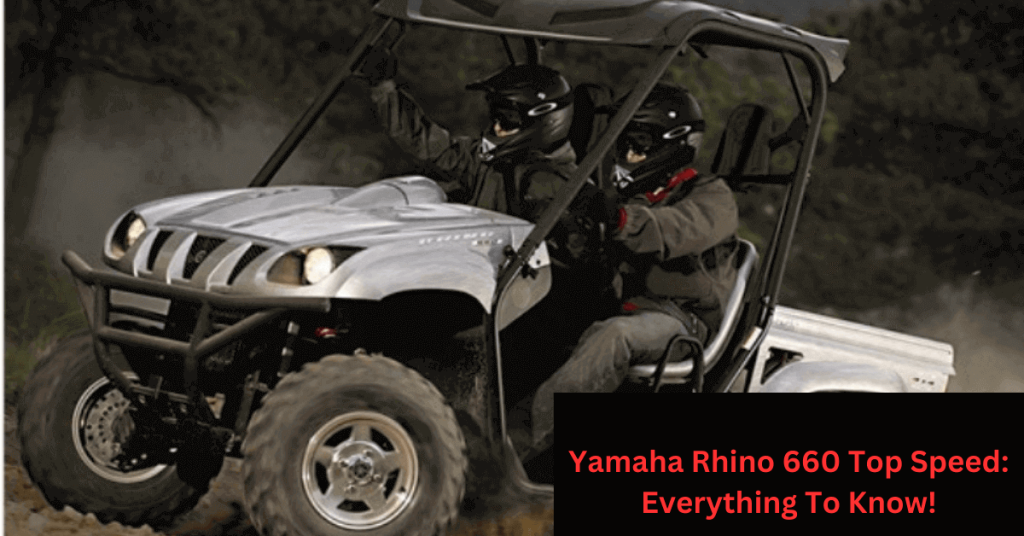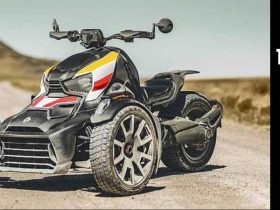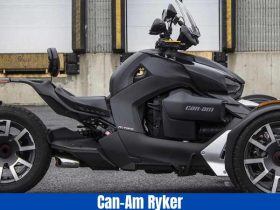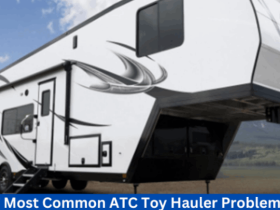
The Yamaha Rhino 660 is a powerful and rugged off-road vehicle designed for work and play. With a liquid-cooled, 4-stroke engine and an automatic transmission, the Rhino 660 can reach top speeds of up to 50 MPH.
The engine delivers smooth and responsive power, making it easy to navigate challenging terrain. The Rhino 660 features independent suspension on all four wheels. While this provide excellent handling and stability, even on rough trails.
The comfortable cab includes bucket seats, a digital instrument panel, and a roll cage for added safety. The Rhino 660 is a versatile and reliable machine. Furthermore, it suits well for outdoor activities, from hunting and farming to recreational trail riding.
Here we’ll discuss everything about the Yamaha Rhino 660 Top Speed. Read on to know!
Yamaha Rhino 660 Top Speed
Yamaha Motor Company produced the Yamaha Rhino 660 from 2004 to 2007. It was part of Yamaha’s Rhino line of side-by-side off-road vehicles. One can use it for both recreational and utility use. A liquid-cooled, 4-stroke engine powers the Rhino 660 with a displacement of 660cc and has an automatic transmission with high and low gear ranges & reverse.
It featured an independent suspension system with hydraulic disc brakes on all four wheels and had a towing capacity of up to 1,212 pounds. The Rhino 660 also had a comfortable and spacious cab with two bucket seats and a roll cage for added safety. In 2008, the Rhino 660 was replaced by the Rhino 700, which featured a larger and more powerful engine, improved suspension, and other upgrades.
Yamaha Rhino 660 Top Speed: Specs, Features & More!
Engine
The 660cc, liquid-cooled, 4-stroke engine was a reliable and efficient powerplant & suited well for off-road use. It had a single overhead camshaft and a 5-valve head, which helped to optimize power delivery and fuel efficiency.
Horsepower and Torque
The engine delivered 34 horsepower and 39 lb-ft of torque, which provided strong acceleration and pulling power for hauling loads or navigating challenging terrain.
Transmission
The Rhino 660’s fully automatic Ultramatic transmission featured high, low, and reverse gears, also an automatic centrifugal clutch. It provided smooth and responsive power delivery, making it easy to tackle difficult obstacles or climb steep hills.
4-Wheel Drive System
The Rhino 660 had a selectable 4-wheel drive system with a limited-slip front differential and a locking rear differential. It allowed the driver to adjust the vehicle’s traction depending on the conditions, providing excellent control and stability on all types of terrain.
Suspension
The Rhino 660 featured a fully independent suspension system with dual A-arms and 7.3 inches of travel. It provided excellent handling and a smooth ride, even on rough or uneven terrain.
Brakes
The vehicle had hydraulic disc brakes on all four wheels, which provided strong and reliable stopping power even in challenging conditions.
Cargo Capacity
The Rhino 660 had a cargo bed capacity of 400 pounds, which allowed for hauling supplies or equipment. It also had a towing capacity of up to 1,212 pounds, which made it a versatile vehicle for work or play.
Cab Features
The Rhino 660 had a spacious and comfortable cab with two bucket seats, a digital instrument panel, and a roll cage for added safety. The cab was well-designed for long rides, with ample legroom and good visibility.
The battery of the Yamaha Rhino 660
The battery of the Yamaha Rhino 660 was a crucial component that played a vital role in the vehicle’s performance and functionality. Further, its sealed design made it maintenance-free. It was also resistant to leaks or spills, making it convenient and reliable.
The battery could withstand the harsh conditions of off-road use with its high-quality materials. Also, with a capacity of 18 amp-hours, the battery provided ample power for the Rhino 660’s electrical components. While this ensure reliable performance for long rides or demanding work.
It was located under the driver’s seat. Also, easily accessible for maintenance and replacement, allowing for quick and easy servicing. It was better to use only Yamaha-approved batteries. In order to ensure proper compatibility and optimal performance.
Yamaha Rhino 660 Top Speed Accessory
The Yamaha Rhino 660 was a popular off-road vehicle with various accessories. That enhanced its functionality and performance. In addition to its standard features, the Rhino 660 had several optional accessories that were available for purchase, such as:
Roof
Rhino 660 had a roof accessory for weather protection, such as sun, rain, or snow. The roof was made of durable materials such as plastic or canvas and easily attached or removed.
Windshield
A windshield accessory could be added to the Rhino 660, providing protection from wind, dust, and debris. The windshield was made of shatter-proof plastic or tempered glass and could be either fixed or adjustable.
Cargo bed
Rhino 660’s cargo bed could be better with several accessories, such as cargo nets, cargo boxes, or cargo racks. These accessories provided additional storage space. while this made it easier to transport gear, equipment, or supplies.
Lights
Is it possible to add headlights, tail lights, and LED light bars to the Rhino 660? These accessories improved visibility during nighttime rides, making them safer and more enjoyable.
Winch
It is possible to add a winch accessory to the Rhino 660, which provided the ability to pull or lift heavy objects, such as fallen trees or rocks. The winch was mounted to the vehicle’s front or rear and was controlled by a remote switch.
Yamaha Rhino 660 accessories added convenience, functionality, and performance for its users. While allowing them to customize their riding experience according to their needs.
How To Replace The Choke Cable On A Yamaha Rhino 660
The choke cable on a Yamaha Rhino 660 controls the engine’s air-fuel mixture during cold starts. Over time, the choke cable may become worn or damaged, requiring replacement to ensure smooth engine performance. However. one can replace the choke cable on a Yamaha Rhino 660 with basic tools and mechanical knowledge.
In order to replace the choke cable, start by locating the cable on the left-hand side of the vehicle. That is near the handlebars. Take note of how the old cables were attached and routed when removing them. It also may be helpful to take a photo or make a diagram to aid in reassembly.
Next, install the new cable, making sure to route it in the same way as the old cable. Moreover, use the pliers or wrench to attach the new cable. In order to the choke lever and carburetor, ensuring a secure fit. Then test it to ensure that the choke is engaging and disengaging properly.
Replacing the choke cable on a Yamaha Rhino 660 is a quick and easy fix. That also can help maintain the vehicle’s performance and reliability. By following these simple steps, you can replace the choke cable on your Yamaha Rhino 660 with ease.
Conclusion
The Yamaha Rhino 660 was a versatile off-road vehicle that offered exceptional performance and functionality. However, with a powerful 660cc engine, robust suspension system, and rugged design, the Rhino 660 could tackle tough terrain. Also, demanding the workloads.
However, its ability to seat up to two passengers made it a popular choice for outdoor enthusiasts, ranchers, and farmers alike. The Rhino 660 also came with a range of accessories and upgrades, such as winches, ploughs, and cargo racks, & enhanced its versatility and utility.
While the Rhino 660 is no longer in production, it remains a sought-after vehicle in the used market. But with many owners still enjoying its rugged performance and dependable functionality.
FAQs
What is the value of a 660 rhino?
On average, it ranges from $5,000 to $10,000.
What is the top speed of a Yamaha Rhino 660?
The top speed of a Yamaha Rhino 660 is around 50 mph. However, the actual top speed can vary based on terrain, payload, and altitude.










Leave a Reply